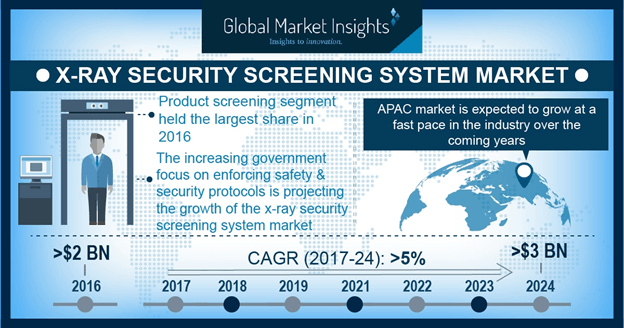X-Ray security screening system market to amass lucrative gains from aviation sector, Asia Pacific to emerge as a prominent regional contender
Publisher : Fractovia | Published Date : 2018-02-06Request Sample
Given the current threats associated with terrorism & illegal activities, the growth prospects of X-ray security screening system market seem to be rather pronounced in the ensuing years. Quite overtly, the alarming rise in drugs & weapons trafficking, illegal arms trade, smuggling, and illegal immigrations have triggered the dire need for efficient security screening systems at transit locations. In response to this fact, advanced technologies that can offer enhanced security, such as the X-ray scanners, are gaining considerable traction, especially from the naval & aviation industry. The ability of these screening systems to detect even trace amount of contrabands placed inside large baggage containers and suitcases have mandated the installation of these systems at public locations, in turn fueling X-ray security screening system industry size.
China x-ray security screening system market size, by end-use, 2016 & 2024 (USD Million)

Estimates claim that more than 2 million commercial aviation passengers are screened in the US on daily basis for weapons & other dangerous articles at airports. According to a report, in the year 2006, the TSA (Transportation Security Administration) security officers intercepted around 13.7 million prohibited items at security checkpoints, thanks to the rising deployment of X-ray security screening systems. Moreover, the rising government focus on installing X-ray security screening systems specially at places that attract larger crowd, have further provided significant impetus to the global X-ray security screening system industry share. This presumption is significantly validated by a trusted report that claims X-ray security screening system market size to have stood at USD 2 billion in 2016.
Demonstrating a recent instance validating the huge demand for security screening system is of Smith Detection’s, a leading X-ray security screening system industry player, move of supplying full range of security scanners, which includes a total of 91 X-ray security & inspection systems, for the newly constructed passenger Terminal B as well as the Cargo Complex at Moscow’s Sheremetyevo International Airport. Reportedly, the deal comes on the heels of the preparation works for the 2018 FIFA World Cup that is to be held in Russia. Industry analysts speculate that the new facilities are part of the airport’s plan to handle the increased passenger traffic and would certainly contribute toward enhancing the regional X-ray security screening system industry share.
APAC X-ray security screening system market to emerge as lucrative hotbed for future investments
One of the impelling factor behind Asia Pacific being a new investment hub for X-ray security screening system market players is its robustly expanding aviation industry. Amidst the backdrop of a growing middle & upper middle-class population in key emerging economies and the momentous growth of intercontinental hubs in APAC, the regional air transport market is continuously expanding its nucleus. According to reliable reports of November 2017, the passenger traffic at Asia Pacific airports grew by 11% than that recorded in the previous year. Rapid industrialization & urbanization trends in countries such as China, India, Indonesia, and Korea, have drastically fueled passenger travels in both the domestic and international sector, consequently leading to Asia Pacific evolving as a rather profitable ground for X-ray security screening system market growth. It is imperative to mention that the anticipated growth in global airport security industry, which has a target CAGR of 7% over 2017-2024 will remarkably impact the revenue graph of X-ray security screening system market in the coming years.
A notable instance that validates the rising deployment of X-ray security scanners is of Astrophysics, who in partnership with a local dealer is all gearing up to deliver over 100 X-ray scanners for checkpoint security at the 2018 Winter Olympics and Paralumpics in Pyeongchang, South Korea. According to sources, the contract calls for machines that runs a gamut from XIS-6040 checkpoint units up to XIS-1517 cargo scanners to secure the venues and inspect shipments at the Olympic Games. Such moves which are overt to encompass the security spectrum of aviation industry in the coming years are overt to leave a substantial impact on the X-ray security screening system industry landscape
X-ray security screening scanners have become an ideal choice to detect threats in high risk public locations, pertaining to their ability to detect drugs, metals, weaponry, and other likes of contraband within a package or on a person’s body. Citing a relevant instance - The TSA authorities intercepted around 11.6 million lighters and 1.6 million knives (in 2006) and more than 2,653 firearms (2015) in luggage bags at airport security checkpoints at the US airports, registering a significant increase from previous records. The data goes on to validate the importance of highly efficient X-ray security scanners and their subsequently high demand from airports, shopping malls, hotels and other crowded and threat prone locations, providing a substantial impetus to x-ray security screening system market trends.
Amidst the backdrop where the prevalence of sophisticated crimes and infrastructure security demand are slated to increase parallelly, it is rather overt for the global X-ray security screening system market to garner massive proceeds in the coming years. Speaking of the competitive landscape, the X-ray security screening system industry comprises some renowned names including MinXray, Inc., Adani Systems Inc., Kapri Corp, L-3 Communications Security & Detection Systems, and Westminster International Ltd., that are vigorously investing in R&D to stay ahead of the competitors, in terms of geographical reach and product & services portfolio. All in all, fueled by these dynamic trends, the overall X-ray security screening system market size is slated to surpass USD 3 billion by 2024.